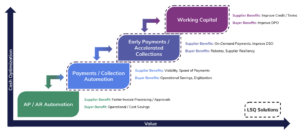Author
Andy Cagle
Share
In the previous blog in this series, I talked about how “cash is king,” especially during times of uncertainty. However, one with hyper-inflation and rising interest rates, whole new dimensions are arising to managing payments and working capital.
Understanding your company’s level of maturity in the source-to-settlement process becomes even more important as you look to determine both tactical and strategic course of action.
If you recall our maturity model, you will remember that you can jump into any of these process phases and move up and down. Each process phase may have its own maturity level within your company, so the next step is to determine what overall level of maturity your company has for the accounts payable (AP) and accounts receivable (AR) automation to working capital maturity curve.

Maturity Framework
Maturity can be defined by four categories, going from least mature to most mature:
- Reactive
- Responsive
- Proactive
- Innovative
Reactive and responsive levels are typically tactical levels of maturity. You’re doing something because it must be done, but do not view it as strategic or able to provide competitive differentiation or contribution to the bottom or top line.
Proactive and innovative are strategic levels. The company views these processes as important to the success of the business and as such, invest in being the most efficient and effective as possible. Additionally, these processes may contribute to the top and/or bottom line and lead to the ability to create a competitive differentiation in the market.
Characteristics of each of these levels are:
Reactive
- Assign minimal resources to manage these requests, but find the process difficult
- Primarily utilize paper-based and/or a manual labor to manage process
- Primarily utilize outdated technologies, such as mail, fax, or email
- Processes, especially payments, are often late due to internal or customer errors, causing frequent invoice inquiries/disputes
- View the business process as necessary due to customer or business demands, but we’re only doing what is necessitated by customers and the market
Responsive
- Have member of staff and dedicated resources or are starting to put together a team to manage these process
- Can receive orders electronically, but are unable to receive electronic invoices or send electronic payments
- Varies by supplier or product order — some suppliers receive on-time payments, but others have frequent disputes that make them payments late
- Realize they have to do something to remain competitive and grow their businesses, but are still assessing the value it might give or passively implementing it as budgets enable
- For working capital, you are experimenting with it, but haven’t fully embraced working capital management.
Proactive
- Have well-established resources, systems and processes in place to respond to rapidly changing market conditions and trading partner requests
- Encourage and support trading partners efforts to collaborate and share efficiencies across the value chain
- Able to accept and deliver electronic documents and payments throughout the source-to-settlement cycle
- Actively seeks internal opportunities to drive greater process efficiency and gain trading partner satisfaction
- MOST IMPORTANTLY, you have a strategy, but haven’t fully determined the total benefits or how they will move forward
Innovative
- Proactively reaching out to trading partners to encourage them to transact all documents electronically
- Trading partners actively participate in working capital programs (i.e., supply chain financing, dynamic discounting, etc.) allowing each trading partner to get paid by their own terms
- See collaborative payments and working capital as a strategic growth and trading partner retention opportunity and are aggressively seeking partners to engage in your payments and working capital strategy plan
- Are using collaborative payments and working capital as a vehicle to drive strategic growth and create innovative products and services
So Where Do We Fall?
For the AP/AR automation, payments/collections automation, early payments/accelerated collections, and working capital process, answer these six questions to determine where in the maturity matrix your organization sits.
- What do you do when a trading partner asks you to transact with them electronically (e.g., electronic invoicing, payments etc.)?
-
- We assign one-off resources to manage these requests, but find the process difficult.
- We have a staff person or are starting to put together a team to manage these requests.
- We have well-established resources, systems, and processes in place to respond to these requests.
- We’re proactively reaching out to trading partners to encourage them to transact with us electronically.
- How easy is it for your trading partners to transact with you?
-
- We primarily receive/send paper-based invoices and payments and/or manual processes to transact with your trading partners.
- We have mostly paper invoicing and payments, but some electronic transactions that are hard to maintain and manage, resulting in electronic being the exception rather than the rule for transacting. .
- We are gradually migrating to electronic invoicing and payments, but worry that some trading partners are being left behind.
- Our trading partner can easily collaborate and transact both invoicing and payments with us.
- How efficient are your payment efforts?
-
- Our suppliers constantly call us because we miss our payments due to our mostly manual processes to approve invoices for payments.
- Certain suppliers contact us for collections because of consistent misalignment with invoice and payment data, resulting in payments always being late and going into collections. .
- We offer some early payment programs for our suppliers to avoid late payments and collections, but our strategy of extending terms may result in specific invoices going into collections if they do not participate in our early-payments options. .
- Collections are not an issue because we offer our suppliers the opportunity for early payments through working capital programs. As such they are able to set their own terms.
- Do you typically make customer payments on time?
-
- Payments are often late due to internal or invoicing or accounts payable errors, causing frequent invoice inquiries/disputes.
- It varies by supplier or products ordered—some pay on time, but others have frequent disputes that make them pay late, or the product complexities result in pricing issues.
- Most we pay on time, and any delays are primarily due to non-electronic payment methods.
- Our suppliers are getting paid early due to our electronic invoicing and working capital/early payment capabilities and options.
- How does your company view account payable function and AP automation?
-
- As necessary due to business demands, but we’re only doing what is necessitated by trading partners to make payments.
- We realize we have to do something to remain competitive and increase efficiency of our business, but we are still assessing the value it might give us or passively implementing it as budgets enable.
- We have assessed the value to our organization and are actively seeking internal opportunities to drive greater process efficiency and gain trading partner satisfaction.
- We see it as a strategic growth and working capital opportunity and are aggressively seeking trading partners to engage in our electronic payments and AP automation approach.
- What is your company’s approach to working capital programs with your trading partners?
-
- We haven’t done anything, but we’re in the process of evaluating how it fits for us.
- We’re experimenting with it.
- We have a strategy, but haven’t fully determined the total benefits or how we will move forward.
- We’re using it as a vehicle to drive strategic growth.
Scoring Your QuizAdd up the total number of responses you had for each letter, then circle the letter for which you had the highest score. A: ___ B: ___ C: ___ D: ___ Interpreting Your ResultsBased on your quiz score, determine the maturity level your company currently falls into from the list below. In the next blog in this series, we will discuss strategies to move up the AP to working capital maturity curve. Mostly As—Your Company Is Reactive Mostly Bs—Your Company Is Responsive Mostly Cs—Your Company Is Proactive Mostly Ds—Your Company Is Innovative |
Stay in the loop




![LSQ-merger_Logo_Stacked_white[84]](https://www.lsq.com/wp-content/uploads/2025/02/LSQ-merger_Logo_Stacked_white84-200x97.png)
